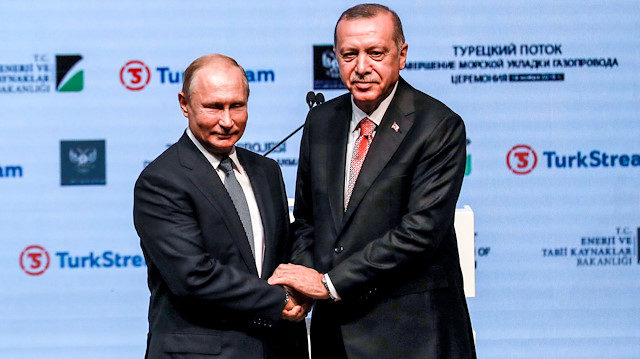
Russian and Non-Russian Pipelines to Supply Gas to Southern Europe Charge Ahead
Publication: Eurasia Daily Monitor Volume: 15 Issue: 167
By:

Russia’s Gazprom has completed the underwater portion of the TurkStream pipeline, which will be able to carry 15.75 billion cubic meters (bcm) of natural gas a year under the Black Sea, through Turkey, and on to Europe. At a ceremony marking the occasion, Presidents Recep Tayyip Erdoğan of Turkey and Vladimir Putin of Russia said the milestone underscored the strengthening partnership between their countries. Erdoğan praised Russia as a reliable energy supplier, while Putin hailed Turkey’s growing importance as an energy and strategic hub (Yeni Shafak, November 19).
The world’s largest multi-purpose vessel, Pioneering Spirit, completed the two underwater sections of the 930-kilometer-long TurkStream in just six months. The first segment was finished in May. Allseas, the Swiss owner of the vessel, immediately sent it to the Baltic Sea, where it will finish the underwater segment of the 55 bcm Nord Stream Two pipeline, which will carry Russian gas to Germany and beyond (Allseas.com, accessed November 26). Gazprom recently completed a 200-kilometer segment of that project in German and Finnish waters (see EDM, November 14). Nord Stream Two will double the 55 bcm of gas capacity already available via Nord Stream One, along more or less the same route on the Baltic Sea floor.
Gazprom must overcome formidable geopolitical and regulatory challenges before it can sell TurkStream gas in the European Union. In 2014, Russia scrapped a previous Black Sea project, South Stream, because of these challenges. That pipeline would have made landfall in Bulgaria (see EDM, December 9, 2013; June 9, 2014; July 17, 2014).
Gazprom now needs to build the onshore component of TurkStream, which will run from Turkey to the Balkans, in a way that satisfies the EU. This pipeline would allow Gazprom to deliver gas to southern Europe without going through Ukraine. Moscow has had a contentious relationship with Kyiv that has included many pipeline disputes over the past two decades. Gazprom wants to extend TurkStream to the Balkans before its transit contract with Ukraine expires at the end of 2019. At the moment, it sends nearly 16 bcm of gas a year through the Trans-Balkan Pipeline between Ukraine and Bulgaria.
Finishing TurkSteam before the expiration of Gazprom’s contract with Ukraine would prevent a repeat of the gas-delivery public relations disaster that Russia suffered in Europe in 2009. A Moscow-Kyiv dispute over pipeline transit fees that year led to a two-week interruption in gas deliveries to Europe. The Balkans were affected worst, with many unable to heat their homes in the dead of winter. The episode tarnished Russia’s 40-year reputation as a reliable gas supplier to Europe (see EDM, January 5, 13, 2009). The planned Russian alternatives to Ukraine’s pipeline network—TurkStream in the south and Nord Steam Two in the north—would give Gazprom more bargaining power in its gas transit negotiations with Ukraine and the European Union.
Meanwhile, however, work on a rival pipeline to supply Azerbaijani gas to southern Europe is racing ahead as well. The Southern Gas Corridor—a chain of linked pipelines across the South Caucasus, Turkey and the southern Balkans, culminating in Italy—which will supply 10 bcm per year of Azerbaijani gas to southern Europe and beyond, is on track to open in 2020. The pipeline consortium recently linked its two westernmost segments—the Trans-Anatolian Pipeline (TANAP) and the still-under-construction Trans-Adriatic Pipeline (TAP)—at the Turkish-Greek border (Azernews.az, November 21).
TAP, which is 80 percent completed, will supply gas to Greece and Italy (Trend, November 13). The Italian government approved it in October, against the wishes of the Five Star Movement, an environmentally oriented, populist political party that is part of the governing coalition. Five Star was supporting Italians who worry that the pipeline, which will emerge from the Adriatic Sea in the Puglia region, will damage the environment (Reuters, October 28; see EDM, November 26).
BP and the State Oil Company of Azerbaijan Republic (SOCAR), whose 20 percent stakes make them the largest TAP shareholders, say the project is coming in under budget. Jo Murphy, the vice president in charge of BP’s work, said the company’s costs are 20 percent below estimates. The final TAP price tag is expected to be $40 billion, or 9 percent below the original estimate of $45 billion (Platts, November 21).
Although Gazprom and the Southern Gas Corridor consortium have said that they do not consider their projects rivals, both aim to deliver gas to southeastern Europe. The EU and the United States want other countries to send supplies through the Southern Gas Corridor, so that it becomes a full-fledged competitor to Gazprom and helps the region reduce its dependence on Russian energy exports. Options (of various likelihood) for additional exporters to join the Southern Gas Corridor include Turkmenistan, northern Iraq and producers operating in the Eastern Mediterranean Sea.
Azerbaijan’s President Ilham Aliyev made his first official visit to Turkmenistan last week (November 23), after the five countries bordering the Caspian Sea signed an agreement specifying how much of the territorial waters belongs to each (Trend, November 23). Their agreement opens the way to a long-discussed Trans-Caspian Pipeline, which could send gas from Turkmenistan and Kazakhstan to Azerbaijan and on to Europe. The energy situation in Europe is more dynamic today than it has been in many years, with a number of projects competing for investment and market share. But the outcome for medium-to-long-term European energy security will be contingent on which projects manage to come online first.



